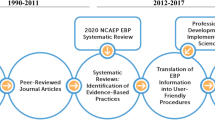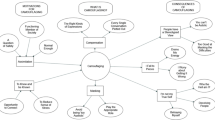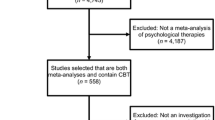Abstract
The Picture Exchange Communication System (PECS) is a communication program that has become widely used, especially with children with autism. This paper reports the results of a review of the empirical literature on PECS. A descriptive review is provided of the 27 studies identified, which included randomized controlled trials (RCTs), other group designs and single subject studies. For 10 appropriate single subject designs the percentage of nonoverlapping data (PND) and percentage exceeding median (PEM) metrics were examined. While there are few RCTs, on balance, available research provides preliminary evidence that PECS is readily learned by most participants and provides a means of communication for individuals with little or no functional speech. Very limited data suggest some positive effect on both social-communicative and challenging behaviors, while effects on speech development remain unclear. Directions for future research are discussed including the priority need for further well-conducted RCTs.
Similar content being viewed by others
Notes
For pre-test post-test designs, effect sizes were calculated by subtracting the pretest mean from the post-test mean and dividing by the pooled standard deviation. For studies involving a comparison group, effect sizes were calculated by subtracting the mean of the control or alternate treatment group from the mean of the PECS intervention group and dividing by the pooled standard deviation.
References
Adkins, T., & Axelrod, S. (2001). Topography—versus selection-based responding: Comparison of mand acquisitions in each modality. The Behavior Analyst Today, 2, 259–266.
Allison, D. B., & Gorman, B. S. (1993). Calculating effect sizes for meta-analysis: The case of the single case. Behaviour Research and Therapy, 31, 621–631. doi:10.1016/0005-7967(93)90115-B.
American Psychiatric Association. (2000). Diagnostic and statistical manual of mental disorders: DSM-IV-TR (4th ed.). Washington, DC: Author.
Bellini, S., & Akullian, J. (2007). A meta-analysis of video modeling and video self-modeling interventions for children and adolescents with autism spectrum disorders. Exceptional Children, 73, 264–287.
Bock, S. J., Stoner, J. B., Beck, A. R., Hanley, L., & Prochnow, J. (2005). Increasing functional communication in non-speaking preschool children: Comparison of PECS and VOCA. Education and Training in Developmental Disabilities, 40, 264–278.
Bondy, A. S., & Frost, L. A. (1993). Mands across the water: A report on the application of the picture-exchange communication system in Peru. The Behavior Analyst, 16, 123–128.
Bondy, A. S., & Frost, L. A. (1994). The picture exchange communication system. Focus on Autistic Behavior, 9, 1–19.
Bondy, A. S., & Frost, L. A. (1995). Educational approaches in preschool: Behavior techniques in a public school setting. In E. Schopler & G. B. Mesibov (Eds.), Learning and cognition in autism (pp. 311–333). New York: Plenum Press.
Bondy, A. S., & Frost, L. A. (1998). The picture exchange communication system. Seminars in Speech and Language, 19, 373–389. doi:10.1055/s-2008-1064055.
Bondy, A. S., & Frost, L. A. (2002). A picture’s worth: PECS and other visual communication strategies in autism: Bethesda. MD, US: Woodbine House.
Bormann, I. (2003). Digitizelt (Version 1.5.7) [Computer software]. Braunschweig, Germany: Bormisoft.
Brady, N. C. (2000). Improved comprehension of object names following voice output communication aid use: Two case studies. Augmentative and Alternative Communication, 16, 197–204. doi:10.1080/07434610012331279054.
Campbell, D. T., & Stanley, J. C. (1963). Experimental and quasi-experimental designs for research. Chicago: Rand McNally.
Carr, D., & Felce, J. (2007a). Brief report: Increase in production of spoken words in some children with autism after PECS teaching to phase III. Journal of Autism and Developmental Disorders, 37, 780–787. doi:10.1007/s10803-006-0204-0.
Carr, D., & Felce, J. (2007b). The effects of PECS teaching to phase III on the communicative interactions between children with autism and their teachers. Journal of Autism and Developmental Disorders, 37, 724–737. doi:10.1007/s10803-006-0203-1.
Carter, M. (1999). The effects of an aided augmentative system on communication and speech in a preschool child with developmental delay. Australasian Journal of Special Education, 23, 25–46. doi:10.1080/1030011990230104.
Carter, M., & Wheldall, K. (2008). Why can’t a teacher be more like a scientist? Science, pseudoscience and the art of teaching. Australasian Journal of Special Education, 32, 5–21. doi:10.1080/10300110701845920.
Chambers, M., & Rehfeldt, R. A. (2003). Assessing the acquisition and generalization of two mand forms with adults with severe developmental disabilities. Research in Developmental Disabilities, 24, 265–280. doi:10.1016/S0891-4222(03)00042-8.
Charlop-Christy, M. H., Carpenter, M., Le, L., LeBlanc, L. A., & Kellet, K. (2002). Using the the picture exchange communication system (PECS) with children with autism: Assessment of PECS acquisition, speech, social-communicative behavior, and problem behavior. Journal of Applied Behavior Analysis, 35, 213–231. doi:10.1901/jaba.2002.35-213.
Charlop-Christy, M. H., & Jones, C. (2006). The picture exchange communication system: A nonverbal communication program for children with autism spectrum disorders. In R. J. McCauley & M. E. Fey (Eds.), Treatment of language disorders in children (pp. 105–122). Baltimore, MD: Paul H. Brookes Publishing.
Chiang, H., & Carter, M. (2008). Spontaneity of communication in individuals with autism. Journal of Autism and Developmental Disorders, 38, 693–705. doi:10.1007/s10803-007-0436-7.
Cress, C. J., & Marvin, C. A. (2003). Common questions about AAC services in early intervention. Augmentative and Alternative Communication, 19, 254–272. doi:10.1080/07434610310001598242.
Cummings, A. R., & Williams, W. (2000). Visual identity matching and vocal imitation training with children with autism: A surprising finding. Journal on Developmental Disabilities, 7, 109–122.
Dooley, P., Wilczenski, F. L., & Torem, C. (2001). Using an activity schedule to smooth school transitions. Journal of Positive Behavior Interventions, 3, 57–61. doi:10.1177/109830070100300108.
Dyches, T. T., Davis, A., Lucido, B. R., & Young, J. R. (2002). Generalization of skills using pictographic and voice output communication devices. Augmentative and Alternative Communication, 18, 124–131. doi:10.1080/07434610212331281211.
Erion, J. (2006). Parent tutoring: A meta-analysis. Education & Treatment of Children, 29, 79–106.
Evidence-Based Medicine Working Group. (1992). Evidence-based medicine: A new approach to teaching the practice of medicine. Journal of the American Medical Association, 268, 2420–2425. doi:10.1001/jama.268.17.2420.
Flay, B. R., Biglan, A., Boruch, R. F., Castro, F. G., Gottfredson, D., Kellam, S., et al. (2004). Standards of evidence: Criteria for efficacy, effectiveness and dissemination. Retrieved 10 September, 2008, from http://www.preventionresearch.org/StandardsofEvidencebook.pdf.
Frea, W. D., Arnold, C. L., & Wittinberga, G. L. (2001). A demonstration of the effects of augmentative communication on the extreme aggressive behavior of a child with autism within an integrated preschool setting. Journal of Positive Behavior Interventions, 3, 194–198. doi:10.1177/109830070100300401.
Frost, L. A., & Bondy, A. S. (1994). PECS: The picture exchange communication system training manual. Cherry Hill, New Jersey: Pyramid Educational Consultants, Inc.
Frost, L. A., & Bondy, A. S. (2002). PECS: The picture exchange communication system training manual (2nd ed.). Cherry Hill, New Jersey: Pyramid Educational Consultants, Inc.
Ganz, J. B., & Simpson, R. L. (2004). Effects on communicative requesting and speech development of the the picture exchange communication system in children with characteristics of autism. Journal of Autism and Developmental Disorders, 34, 395–409. doi:10.1023/B:JADD.0000037416.59095.d7.
Gersten, R., Fuchs, L. S., Compton, D., Coyne, M., Greenwood, C., & Innocenti, M. S. (2005). Quality indicators for group experimental and quasi-experimental research in special education. Exceptional Children, 71, 149–164.
Green, V. A., Pituch, K. A., Itchon, J., Choi, A., O’Reilly, M., & Sigafoos, J. (2006). Internet survey of treatments used by parents of children with autism. Research in Developmental Disabilities, 27, 70–84. doi:10.1016/j.ridd.2004.12.002.
Horner, R. H., Carr, E. G., Halle, J., McGee, G., Odom, S., & Wolery, M. (2005). The use of single-subject research to identify evidence-based practice in special education. Exceptional Children, 71, 165–179.
Howlin, P., Gordon, R. K., Pasco, G., Wade, A., & Charman, T. (2007). The effectiveness of picture exchange communication system (PECS) training for teachers of children with autism: A pragmatic, group randomised controlled trial. Journal of Child Psychology and Psychiatry and Allied Disciplines, 48, 473–481. doi:10.1111/j.1469-7610.2006.01707.x.
Keen, D., Sigafoos, J., & Woodyatt, G. (2001). Replacing prelinguistic behaviors with functional communication. Journal of Autism and Developmental Disorders, 31, 385–398. doi:10.1023/A:1010612618969.
Koegel, L. K. (2000). Interventions to facilitate communication in autism. Journal of Autism and Developmental Disorders, 30, 383–391. doi:10.1023/A:1005539220932.
Kravits, T. R., Kamps, D. M., Kemmerer, K., & Potucek, J. (2002). Brief report: Increasing communication skills for an elementary-aged student with autism using the the picture exchange communication system. Journal of Autism and Developmental Disorders, 32, 225–230. doi:10.1023/A:1015457931788.
Lancioni, G. E., O’Reilly, M. F., & Basili, G. (2001). Use of microswitches and speech output systems with people with severe/profound intellectual or multiple disabilities: A literature review. Research in Developmental Disabilities, 22, 21–40. doi:10.1016/S0891-4222(00)00064-0.
Lancioni, G. E., O’Reilly, M. F., Cuvo, A. J., Singh, N. N., Sigafoos, J., & Didden, R. (2007). PECS and VOCAs to enable students with developmental disabilities to make requests: An overview of the literature. Research in Developmental Disabilities, 28, 468–488. doi:10.1016/j.ridd.2006.06.003.
Layton, T. L. (1988). Language training with autistic children using four different modes of presentation. Journal of Communication Disorders, 21, 333–350. doi:10.1016/0021-9924(88)90037-8.
Lee, S.-H., Simpson, R. L., & Shogren, K. A. (2007). Effects and implications of self-management for students with autism: A meta-analysis. Focus on Autism and Other Developmental Disabilities, 22, 2–13. doi:10.1177/10883576070220010101.
Liddle, K. (2001). Implementing the picture exchange communication system (PECS). International Journal of Language and Communication Disorders, 36(Nov 2001 Suppl), 391–395.
Lord, C., Risi, S., Lambrecht, L., Cook, E. H., Jr, Leventhal, B. L., DiLavore, P. C., et al. (2000). The autism diagnostic observation schedule-generic: A standard measure of social and communication deficits associated with the spectrum of autism. Journal of Autism and Developmental Disorders, 30, 205–223. doi:10.1023/A:1005592401947.
Ma, H. (2006). An alternative method of quantitative synthesis of single-subject researches: Percentage of data points exceeding the median. Behavior Modification, 30, 598–617. doi:10.1177/0145445504272974.
Magiati, I., & Howlin, P. (2003). A pilot evaluation study of the picture exchange communication system (PECS) for children with autistic spectrum disorders. Autism, 7, 297–320. doi:10.1177/13623613030073006.
Malandraki, G. A., & Okalidou, A. (2007). The application of PECS in a deaf child with autism: A case study. Focus on Autism and Other Developmental Disabilities, 22, 23–32. doi:10.1177/10883576070220010301.
Marckel, J. M., Neef, N. A., & Ferreri, S. J. (2006). A preliminary analysis of teaching improvisation with the picture exchange communication system to children with autism. Journal of Applied Behavior Analysis, 39, 109–115. doi:10.1901/jaba.2006.131-04.
Millar, D. C., Light, J. C., & Schlosser, R. W. (2006). The impact of augmentative and alternative communication intervention on the speech production of individuals with developmental disabilities: A research review. Journal of Speech, Language, and Hearing Research: JSLHR, 49, 248–264.
Mirenda, P. (1997). Supporting individuals with challenging behavior through functional communication training and AAC: A research review. Augmentative and Alternative Communication, 13, 207–225. doi:10.1080/07434619712331278048.
Mirenda, P. (2003). Toward functional augmentative and alternative communication for students with autism: Manual signs, graphic symbols, and voice output communication aids. Language, Speech, and Hearing Services in Schools, 34, 203–216. doi:10.1044/0161-1461(2003/017).
Parker, R. I., Hagan-Burke, S., & Vannest, K. (2007). Percentage of all non-overlapping data (PAND): An alternative to PND. The Journal of Special Education, 40, 194–204. doi:10.1177/00224669070400040101.
Paul, R. (2005). Assessing communication in autism spectrum disorders. In F. R. Volkmar, R. Paul, A. Klin, & D. Cohen (Eds.), Handbook of autism and pervasive developmental disorders (2nd ed., Vol. 2, pp. 799–816). Hoboken, New Jersey: Wiley.
Quill, K. A. (1997). Instructional considerations for young children with autism: The rationale for visually cued instruction. Journal of Autism and Developmental Disorders, 27, 697–714. doi:10.1023/A:1025806900162.
Rehfeldt, R. A., & Root, S. L. (2005). Establishing derived requesting skills in adults with severe developmental disabilities. Journal of Applied Behavior Analysis, 38, 101–105. doi:10.1901/jaba.2005.106-03.
Reichle, J., & Sigafoos, J. (1991). Establishing an initial repertoire of requesting. In J. Reichle, J. York, & J. Sigafoos (Eds.), Implementing augmentative and alternative communication: Strategies for learners with severe disabilities (pp. 89–114). Baltimore: Paul H. Brookes.
Reynhout, G., & Carter, M. (2006). Social stories for children with disabilities. Journal of Autism and Developmental Disorders.
Romski, M., & Sevcik, R. A. (2005). Augmentative communication and early intervention: Myths and realities. Infants and Young Children, 18, 174–185.
Rosales, R., & Rehfeldt, R. A. (2007). Contriving transitive conditioned establishing operations to establish derived manding skills in adults with severe developmental disabilities. Journal of Applied Behavior Analysis, 40, 105–121. doi:10.1901/jaba.2007.117-05.
Rowland, C., & Schweigert, P. (1989). Tangible symbols: Symbolic communication for individuals with multisensory impairments. Augmentative and Alternative Communication, 5, 226–234. doi:10.1080/07434618912331275276.
Rowland, C., & Schweigert, P. (1990). Tangible symbol systems: Symbolic communication for individuals with multisensory impairments. Tucson, AZ: Communication Skill Builders.
Salzberg, C. L., Strain, P. S., & Baer, D. M. (1987). Meta-analysis for single-subject research: When does it clarify, when does it obscure? Remedial and Special Education, 8, 43–48. doi:10.1177/074193258700800209.
Schwartz, I. S., Garfinkle, A. N., & Bauer, J. (1998). The picture exchange communication system: Communicative outcomes for young children with disabilities. Topics in Early Childhood Special Education, 18, 144–159. doi:10.1177/027112149801800305.
Scruggs, T. E., & Mastropieri, M. A. (1998). Summarizing single-subject research: Issues and applications. Behavior Modification, 22, 221–242. doi:10.1177/01454455980223001.
Scruggs, T. E., Mastropieri, M. A., & Casto, G. (1987). The quantitative synthesis of single subject research: Methodology and validation. Remedial and Special Education, 8, 24–33. doi:10.1177/074193258700800206.
Sigafoos, J., Laurie, S., & Pennell, D. (1996). Teaching children with Rett syndrome to request preferred objects using aided communication: Two preliminary studies. Augmentative and Alternative Communication, 12, 88–96. doi:10.1080/07434619612331277538.
Simon, E. W., Whitehair, P. M., & Toll, D. M. (1996). A case study: Follow-up assessment of facilitated communication. Journal of Autism and Developmental Disorders, 26, 9–18. doi:10.1007/BF02276232.
Smoot, S., Curlette, W., & Deitz, S. (1990). Meta-analysis of single subject research in special education: A common metric & a computerized method. Atlanta, GA: Georgia State University. (ERIC Document Reproduction Service No. ED 322151).
Son, S. H., Sigafoos, J., O’Reilly, M., & Lancioni, G. E. (2006). Comparing two types of augmentative and alternative communication systems for children with autism. Pediatric Rehabilitation, 9, 389–395. doi:10.1080/13638490500519984.
Stoner, J. B., Beck, A. R., Bock, S. J., Hickey, K., Kosuwan, K., & Thompson, J. R. (2006). The effectiveness of the picture exchange communication system with nonspeaking adults. Remedial and Special Education, 27, 154–165. doi:10.1177/07419325060270030401.
Tincani, M. (2004). Comparing the picture exchange communication system and sign language training for children with autism. Focus on Autism and Other Developmental Disabilities, 19, 152–163. doi:10.1177/10883576040190030301.
Tincani, M., Crozier, S., & Alazetta, L. (2006). The picture exchange communication system: Effects on manding and speech development for school-aged children with autism. Education and Training in Developmental Disabilities, 41, 177–184.
Turnell, R., & Carter, M. (1994). Establishing a repertoire of requesting for a student with severe and multiple disabilities using tangible symbols and naturalistic time delay. Australia and New Zealand Journal of Developmental Disabilities, 19, 193–207.
Webb, T. (2000). Can children with autism and severe learning disabilities be taught to communicate spontaneously and effectively using the picture exchange communication system? Good Autism Practice, 1, 29–42.
Westling, D. L., & Fox, L. (2004). Teaching students with severe disabilities (3rd ed.). ed.). Upper Saddle River, New Jersey: Pearson.
What Works Clearinghouse. (2006). Evidence standards for reviewing studies. Retrieved June 15, 2007, from http://www.whatworks.ed.gov/reviewprocess/study_standards_final.pdf.
White, O. R. (1987). Some comments concerning “The quantitative synthesis of single-subject research”. Remedial and Special Education, 8, 34–39. doi:10.1177/074193258700800207.
Xin, Y. P., Grasso, E., Dipipi-Hoy, C. M., & Jitendra, A. (2005). The effects of purchasing skill instruction for individuals with developmental disabilities: A meta-analysis. Exceptional Children, 71, 379–400.
Yoder, P., & Layton, T. L. (1988). Speech following sign language training in autistic children with minimal verbal language. Journal of Autism and Developmental Disorders, 18, 217–229. doi:10.1007/BF02211948.
Yoder, P., McCathren, R. B., Warren, S. F., & Watson, A. L. (2001). Important distinctions in measuring maternal responses to communication in prelinguistic children with disabilities. Communication Disorders Quarterly, 22, 135–147. doi:10.1177/152574010102200303.
Yoder, P., & Stone, W. L. (2006a). A randomized comparison of the effect of two prelinguistic communication interventions on the acquisition of spoken communication in preschoolers with ASD. Journal of Speech, Language, and Hearing Research: JSLHR, 49, 698–711. doi:10.1044/1092-4388(2006/051).
Yoder, P., & Stone, W. L. (2006b). Randomized comparison of two communication interventions for preschoolers with autism spectrum disorders. Journal of Consulting and Clinical Psychology, 74, 426–435. doi:10.1037/0022-006X.74.3.426.
Yokoyama, K., Naoi, N., & Yamamoto, J. (2006). Teaching verbal behavior using the picture exchange communication system (PECS) with children with autistic spectrum disorders. Japanese Journal of Special Education, 43, 485–503.
Author information
Authors and Affiliations
Corresponding author
Rights and permissions
About this article
Cite this article
Preston, D., Carter, M. A Review of the Efficacy of the Picture Exchange Communication System Intervention. J Autism Dev Disord 39, 1471–1486 (2009). https://doi.org/10.1007/s10803-009-0763-y
Received:
Accepted:
Published:
Issue Date:
DOI: https://doi.org/10.1007/s10803-009-0763-y




